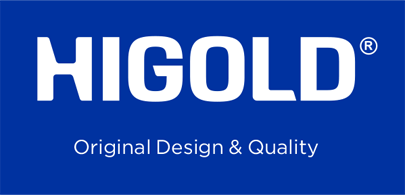As an important part of kitchen equipment, kitchen sink directly affects the efficiency of daily cooking and cleaning. As modern kitchen decoration pays more and more attention to details and quality, it is particularly important to choose a high-quality kitchen stainless steel sink. However, in the market, there are many types of stainless steel sinks, and sinks of different grades have significant differences in material, durability, corrosion resistance, and stain resistance. So, which grade of kitchen stainless steel sink is the best? How should consumers choose the sink that best suits their needs according to the characteristics of different grades?
This article will analyze the grades of kitchen stainless steel sinks in detail, and help consumers make scientific choices from multiple dimensions such as material, process, durability, cleaning and maintenance.
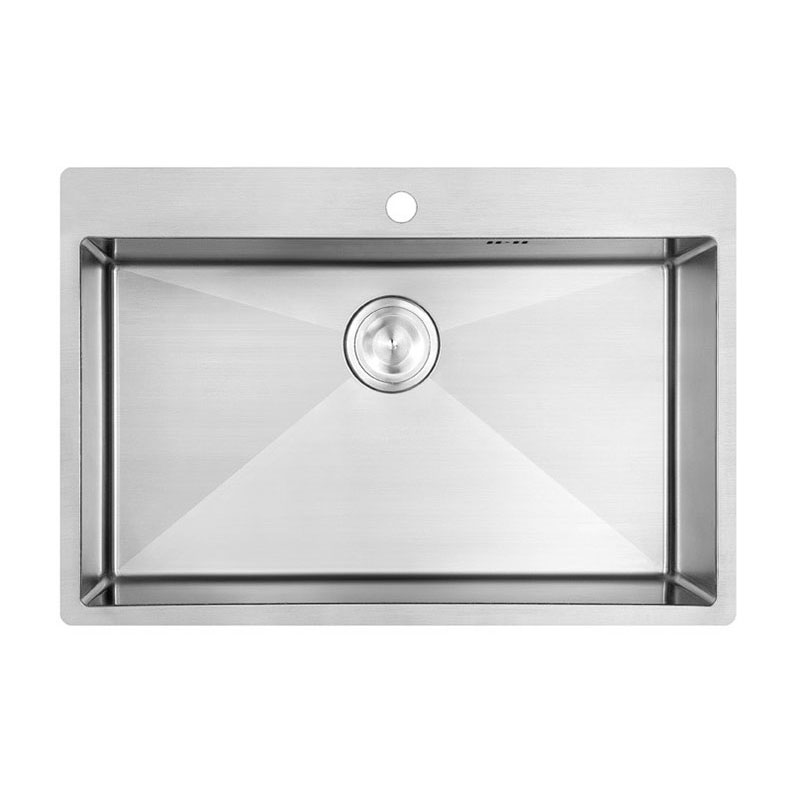
What grades of kitchen stainless steel sinks are there?
The grade division of kitchen stainless steel sinks is mainly based on the composition and process of its stainless steel. Most common high-quality inox sinks use 304 stainless steel, and the main difference between sinks of different grades lies in the model, thickness, and anti-oxidation and anti-corrosion capabilities of their stainless steel. Common grades include 201, 304 and 316 stainless steel, etc. These different types of stainless steel vary in price, durability and performance.
201 stainless steel
201 stainless steel is an economical stainless steel that is mainly used to make low-cost inox sinks. Its main components include iron, chromium and nickel, but the nickel content is relatively low, resulting in its corrosion resistance being inferior to 304 stainless steel. The advantage of 201 stainless steel kitchen sinks is that they are cheap and suitable for consumers with limited budgets, but their durability and oxidation resistance are poor and they are susceptible to corrosion and oxidation.
304 stainless steel
304 stainless steel is the most common and widely used material in kitchen sinks. Its main components are iron, chromium and 18% nickel, so it has excellent corrosion resistance, oxidation resistance and heat resistance. 304 stainless steel kitchen sinks occupy a mainstream position in major kitchen supplies, and have become the first choice of most consumers due to their high durability and strong anti-pollution properties. It is suitable for most family kitchens and has a long service life and relatively stable performance.
316 Stainless Steel
316 stainless steel is a higher grade of stainless steel than 304, with higher nickel and molybdenum content, so it has stronger corrosion resistance and high temperature resistance. 316 stainless steel kitchen sinks are often used in environments with extremely high corrosion requirements, such as kitchens in coastal areas or places with high temperature and humidity. Although it is more expensive than 304 stainless steel, 316 stainless steel sinks are undoubtedly an ideal choice for users who require extremely high durability and corrosion resistance.
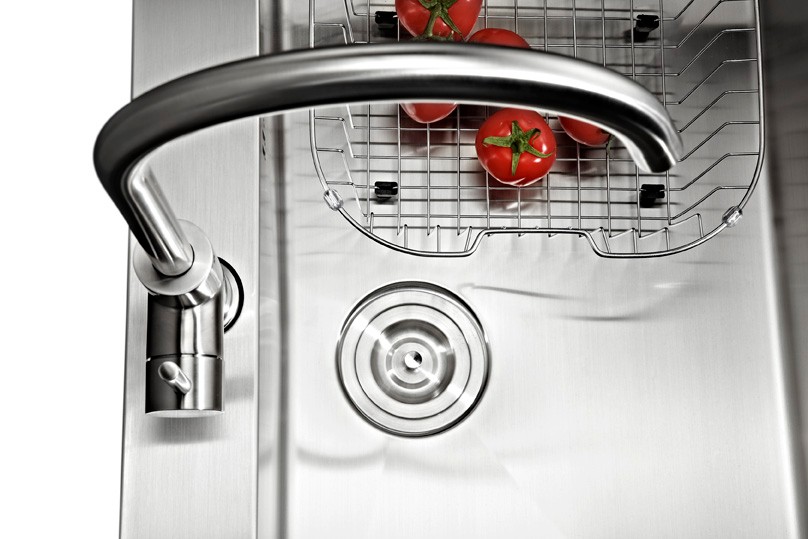
What is the basis for selecting the grade of stainless steel sinks?
When choosing a stainless steel kitchen sink, the grade is an important factor affecting the performance, durability and price of the sink. Different grades of stainless steel sinks have different characteristics, and consumers need to weigh the following aspects to choose the sink that best suits their needs.
Use environment and corrosion resistance requirements
The differences in corrosion resistance of different grades of kitchen stainless steel sinks are particularly significant. 304 stainless steel can usually cope with the use requirements of general kitchen environments, but in environments with strong acids and alkalis, 201 stainless steel may corrode faster due to the lack of sufficient nickel content. For highly corrosive environments, such as seaside kitchens, or kitchens that require long-term contact with acidic substances, 316 stainless steel will provide more excellent corrosion protection.
Durability and oxidation resistance
Due to its unique composition, 304 stainless steel exhibits strong oxidation resistance and durability, and can maintain a smooth surface for a long time and resist daily wear and tear. Therefore, 304 stainless steel sinks are suitable for most homes and commercial kitchens, especially those who use sinks for a long time. 201 stainless steel sinks are more susceptible to oxidation and corrosion, especially in humid or acidic environments, and have a shorter lifespan.
If users have high requirements for the durability of the sink, especially in kitchens with high frequency of use, 304 stainless steel is undoubtedly the best choice. For some kitchens with special needs, 316 stainless steel can provide a longer service life, especially in the face of extreme corrosive environments, the advantages of 316 stainless steel are more obvious.
Price and budget
In terms of price, 201 kitchen stainless steel sinks are the most economical, with low cost, so they are suitable for families with limited budgets. 304 stainless steel sinks are moderately priced and cost-effective, suitable for most families. Although 316 stainless steel sinks are more expensive, they are suitable for users who have higher requirements for kitchen sinks due to their excellent corrosion resistance and high temperature resistance.
From an economic perspective, if the budget is limited, 201 stainless steel sinks are an entry-level choice, but they are not recommended for long-term use or highly corrosive environments. 304 stainless steel sinks are a cost-effective and excellent performance option suitable for most kitchens. If you have higher requirements for kitchen sinks, especially users with extremely high corrosion resistance requirements, choosing 316 stainless steel is more expensive, but in the long run, the durability and corrosion resistance it provides are well worth the investment.
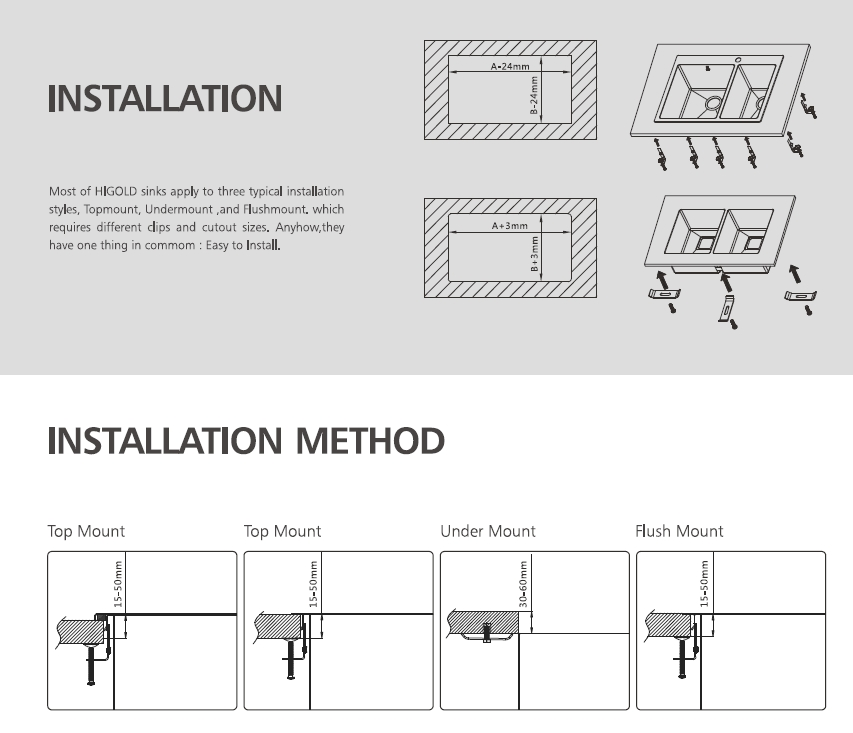
What are the advantages and disadvantages of each grade of inox sink?
Different grades of kitchen stainless steel sinks have different advantages and disadvantages, and understanding these can help consumers make wise choices.
201 stainless steel sink advantages and disadvantages
201 stainless steel sink advantages:
● Cheap price: 201 kitchen stainless steel sinks are less expensive and suitable for consumers with limited budgets.
● Lightweight: Due to the characteristics of the material, 201 inox sinks are usually lighter than 304 and 316 stainless steel sinks, making them easier to carry and install.
Disadvantages of 201 stainless steel sink:
● Poor corrosion resistance: 201 stainless steel has weak corrosion resistance and is prone to oxidation and rust when in contact with moisture, oil and acidic substances for a long time.
● Short service life: In daily use, 201 inox sinks are more susceptible to wear and corrosion, and have a relatively short service life.
Advantages and disadvantages of 304 stainless steel sink
Advantages of 304 stainless steel sink:
● Strong corrosion resistance: 304 kitchen stainless steel sinks have strong corrosion resistance and can cope with most kitchen environments.
● Good durability: 304 stainless steel sinks can maintain stability for a long time in daily use and are not easily damaged.
● Moderate price: Compared with 316 stainless steel, 304 stainless steel sinks are moderately priced and have a higher cost-effectiveness.
Disadvantages of 304 stainless steel sink:
● Not suitable for extreme environments: For very highly corrosive or high-temperature environments, the performance of 304 kitchen stainless steel sinks may decline.
Advantages and Disadvantages of 316 Stainless Steel Sink
Advantages of 316 Stainless Steel Sink:
● Strong corrosion resistance: 316 stainless steel performs well in highly corrosive environments due to its high nickel and molybdenum content, and is particularly suitable for seaside, industrial kitchens or high acid and alkali environments.
● High temperature resistance: 316 stainless steel has strong high temperature resistance and is not easily deformed by high temperature.
Disadvantages of 316 stainless steel sink:
● High price: The price of 316 kitchen stainless steel sink is significantly higher than that of 304 and 201 inox sinks, and is suitable for users with special needs for corrosion and high temperature resistance.
● Heavier: The material of 316 stainless steel sink is relatively strong, so it is heavier. When installing, you need to pay attention to the load-bearing capacity of the countertop.
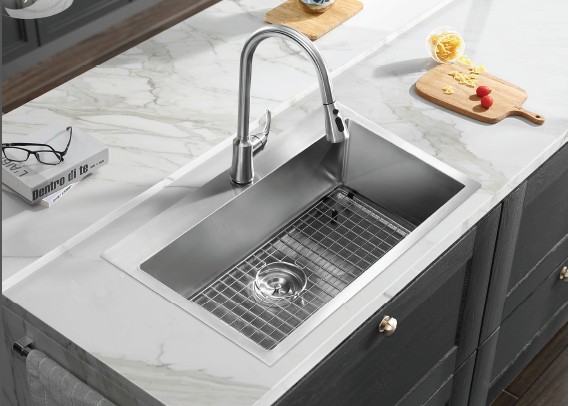
How to choose the most suitable inox sink?
When choosing a kitchen stainless steel sink, consumers should make decisions based on their own kitchen usage needs, budget and kitchen environment. Here are some selection suggestions:
Limited budget
If the budget is limited and the kitchen environment is relatively conventional, the 201 stainless steel sink is an economical choice. However, please note that they have a short lifespan and may need to be replaced periodically.
Most Home Kitchens
For most home kitchens, 304 stainless steel sinks offer the best balance of durability, corrosion resistance, and reasonable price, making them a great choice for daily use.
Special Needs Kitchens
For kitchens located in coastal areas or facing highly corrosive environments, or for those who require extremely high durability, 316 inox sinks are the best choice. Although more expensive, their excellent performance can meet special needs.
High-Quality Stainless Steel Kitchen Sinks at Low Prices
At Higold Group, we are committed to providing high-quality kitchen stainless steel sinks at competitive prices. As a leading manufacturer in China, we supply a wide range of kitchen sinks and faucets, designed to meet international standards. Our products are certified with CUPC, CSA, and CE, ensuring their durability and safety. With over 7 production lines and 20 years of experience, we are capable of handling bulk orders efficiently. Reach out now for your custom order and pricing details.
